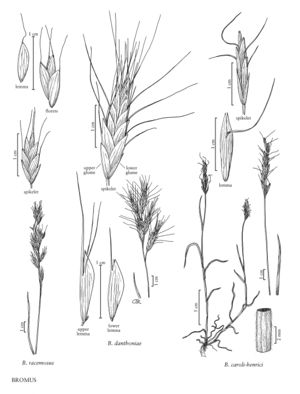Difference between revisions of "Bromus racemosus"
imported>Volume Importer |
imported>Volume Importer |
||
| (One intermediate revision by the same user not shown) | |||
| Line 43: | Line 43: | ||
|publication year= | |publication year= | ||
|special status=Introduced | |special status=Introduced | ||
| − | |source xml=https:// | + | |source xml=https://bitbucket.org/aafc-mbb/fna-data-curation/src/200273ad09963decb8fc72550212de541d86569d/coarse_grained_fna_xml/V24/V24_332.xml |
|subfamily=Poaceae subfam. Pooideae | |subfamily=Poaceae subfam. Pooideae | ||
|tribe=Poaceae tribe Bromeae | |tribe=Poaceae tribe Bromeae | ||
Latest revision as of 16:23, 11 May 2021
Plants annual. Culms 20-110 cm, erect or ascending. Lower sheaths densely hairy, hairs stiff, often retrorse; upper sheaths glabrous or pubescent; ligules 1-2 mm, glabrous or hairy, erose; blades 7-18 cm long, 1-4 mm wide, pilose on both surfaces. Panicles 4-16 cm long, 2-3 cm wide, erect, open; branches sometimes longer than the spikelets, slender, usually ascending, slightly curved or straight. Spikelets 12-20 mm, lanceolate, terete to moderately laterally compressed; florets 5-6, bases concealed at maturity; rachilla internodes 1-1.5 mm, concealed at maturity. Glumes smooth to scabrous; lower glumes 4-6 mm, (3)5-veined; upper glumes 4-7 mm, 7-veined; lemmas 6.5-8 mm long, 3-4.5 mm wide, elliptic to lanceolate, coriaceous, backs smooth, distinctly 7(9)-veined, not ribbed, rounded over the midvein, margins scabrous, rounded, not inrolled at maturity, apices acute to obtuse, bifid, teeth shorter than 1 mm; awns 5-9 mm, all more or less equal in length, straight, arising less than 1.5 mm below the lemma apices; anthers 1.5-3 mm. Caryopses shorter than the paleas, thin, weakly inrolled or flat. 2n = 28.
Distribution
Conn., N.J., N.Y., Wash., Va., Del., D.C., Wis., W.Va., Mass., Maine, N.H., R.I., Vt., Fla., Wyo., N.Mex., Tex., La., N.Dak., Tenn., N.C., S.C., Pa., Calif., Nev., Alta., B.C., N.B., Nfld. and Labr. (Labr.), N.S., N.W.T., Ont., P.E.I., Que., Sask., Colo., Md., Alaska, Ala., Ark., Ill., Ga., Ind., Iowa, Kans., Ariz., Idaho, Nebr., Okla., Ohio, Utah, Mo., Mich., Mont., Miss., Oreg., Ky.
Discussion
Bromus racemosus grows in fields, waste places, and road verges. It is native to western Europe and the Baltic region, and occurs throughout much of southern Canada and the United States. Hitchcock (1951) included B. hordeaceus subsp. pseudothominei in B. racemosus.
Selected References
None.
